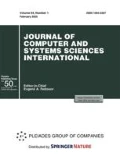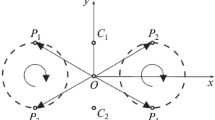Abstract
Formulas are obtained that make it possible to realize a predetermined motion of a rigid body with respect to its center of mass in a coordinate system with this center and translating axes. It is shown that there are two significantly different cases. In the first case, the point should always be in a certain plane, which not only makes it possible to implement any required movement from this class but also allows us to use the ambiguity of the solution so that, for example, the point always moves along the same path in the specified plane. In the second case, the solution turns out to be unique and the material point should have, generally speaking, a separate spatial trajectory for each given program of reorientation of a rigid body. Moreover, in this case only those motions that satisfy the found condition can be realized.


Similar content being viewed by others
REFERENCES
L. D. Akulenko, N. N. Bolotnik, A. E. Borisov, A. A. Gavrikov, and G. A. Emel’yanov, “Orientation control of an object on a rotating base by using a two-stage electric drive,” J. Comput. Syst. Sci. Int. 58, 829 (2019).
M. V. Levskii, “Synthesis of the optimal control of the spacecraft orientation using combined criteria of quality,” J. Comput. Syst. Sci. Int. 58, 980 (2019).
F. Schmoeckel and H. Worn, “Remotely controllable microrobots acting as nano positioners and intelligent tweezers in scanning electron microscopes (SEMs),” in Proceedings of the International Conference on Robotics and Automation (IEEE, New York, 2001), Vol. 4, pp. 3903–3913.
P. Vartholomeos and E. Papadopoulos, “Dynamics, design and simulation of a novel microrobotic platform employing vibration microactuators,” Trans. ASME, J. Dyn. Syst., Meas. Control 128, 122–133 (2006).
F. L. Chernousko, “Two-dimensional motions of a body containing internal moving masses,” Meccanica 51, 3203–3209 (2016).
F. L. Chernousko, “Optimal control of the motion of a two-mass system,” Dokl. Math. 97, 295 (2018).
A. M. Shmatkov, “Time-optimal rotation of the rigid body by a mass point,” Dokl. Akad. Nauk 481, 498–502 (2018).
F. L. Chernousko and A. M. Shmatkov, “Optimal control of rotation of a rigid body by a movable internal mass,” J. Comput. Syst. Sci. Int. 58, 335 (2019).
A. M. Shmatkov, “The implementation of a given motion of a rigid body relative to its center of mass by moving the material point,” Dokl. Akad. Nauk 489, 147–151 (2019).
A. P. Markeev, Theoretical Mechanics (CheRo, Moscow, 1999) [in Russian].
V. F. Zhuravlev, Fundamentals of Theoretical Mechanics (Fizmatlit, Moscow, 2008) [in Russian].
L. S. Pontryagin, V. G. Boltyansky, R. V. Gamkrelidze, and E. F. Mishchenko, The Mathematical Theory of Optimal Processes (Nauka, Moscow, 1969; Wiley, New York, London, 1962).
Ya. N. Roitenberg, Automatic Control (Nauka, Moscow, 1992) [in Russian].
P. K. Rashevskii, Differential Geometry Course (GITTL, Moscow, Leningrad, 1950) [in Russian].
Funding
This work was supported by the Russian Science Foundation, grant no. 18-11-00307.
Author information
Authors and Affiliations
Corresponding author
Rights and permissions
About this article
Cite this article
Shmatkov, A.M. Objects Changing the Spatial Orientation of a Solid Body by Using Mobile Mass. J. Comput. Syst. Sci. Int. 59, 622–629 (2020). https://doi.org/10.1134/S1064230720040139
Received:
Revised:
Accepted:
Published:
Issue Date:
DOI: https://doi.org/10.1134/S1064230720040139




